Electrical Technology: Digital Grade 12 Memorandum - NSC Past Papers And Memos September 2020 Preparatory Examinations
Share via Whatsapp Join our WhatsApp Group Join our Telegram GroupINSTRUCTIONS TO MARKERS
- All questions with multiple answers imply that any relevant, acceptable answer should be considered.
- Calculations:
2.1 All calculations must show the formulae.
2.2 Substitution of values must be done correctly.
2.3 All answers MUST contain the correct unit to be considered.
2.4 Alternative methods must be considered, provided that the correct answer is obtained.
2.5 Where an incorrect answer could be carried over to the next step, the first answer will be deemed incorrect. However, should the incorrect answer be carried over correctly, the marker has to re-calculate the values, using the incorrect answer from the first calculation. If correctly used, the candidate should receive the full marks for subsequent calculations.
2.6 Markers should consider that candidates’ answers may deviate slightly from the marking a guideline depending on how and where in the calculation rounding off was used. - These marking guidelines are only a guide with model answers.
- Alternative interpretations must be considered and marked on merit. However, this principle should be applied consistently throughout the marking session at ALL marking places.
MEMORANDUM
QUESTION 1: OCCUPATIONAL HEALTH AND SAFETY
1.1 Accident means an incident arising out of and in the course of an employee’s employment and resulting in a personal injury, illness or the death of the employee. (2)
1.2
- Take reasonable care for the health and safety of him/herself and of other persons who may be affected by his or her act.
- Cooperate with the employer or persons to enable that any duty given by the requirements and procedures.
- Carry out any lawful order given to him, and obey the health and safety rules and procedures laid down by his employer or by anyone authorised there by his employer, in the interest of health or safety
- If any situation which is unsafe or unhealthy comes to his/her attention, as soon as practicable report this to his/her employer, or a healthy and safety representative who should report it to the employer. (2)
1.3
- Horseplay
- Running in the workshop.
- Throwing things.
- Leaving bags, stools or material in the walkway.
- Spilling a liquid or oil without cleaning.
- Any relevant answer (2)
1.4 Third degree burn: where all layers of skin have been burned, causing permanent skin damage affecting fat, muscle and even bone. (2)
1.5
- To review the effectiveness of health and safety measures.
- To identify hazards and potential major incidents at the workplace. (2)
[10]
QUESTION 2: SWITCHING CIRCUITS
2.1 An astable multivibrator generates a continuous series of pulses without the need for a trigger pulse. (2)
2.2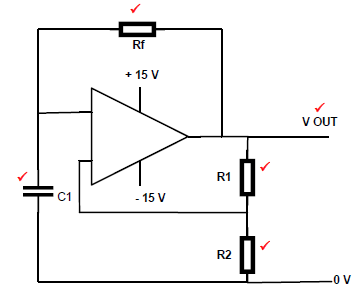 (5)
(5)
2.3.1
- Resistors R1 and R2 are pull-up resistors.
- Resistors R1 and R2 will hold both trigger pin 2 and reset pin 4 high. (2)
2.3.2 Trigger pin 2 will be pulled low and cause the IC output to ‘flip’ and rise high turning the LED on when set switch S1 is pressed. (3)
2.3.3 Threshold pin 6 is purposely held at O V causing the IC not to reset, keeping the output high when S1 is pressed. (3)
2.4
2.4.1 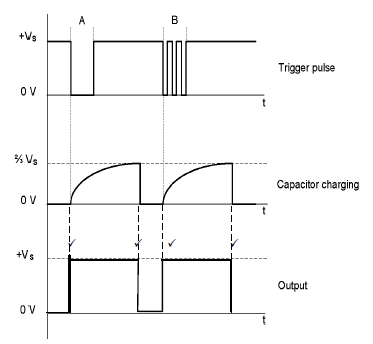 (4)
(4)
2.4.2 Trigger pulse B looks like a series of ‘on’ and ‘off’ pulses. This is known as switch bounce. (2)
2.4.3 The duration of time of trigger pulse B will not influence the condition of the circuit and for that reason will the charge tempo of the capacitor not be influenced. (3)
2.5
2.5.1
- The output signal represents an inverting Schmitt trigger because the output signal is inverted with reference to the input signal.
OR - The output signal is at –Vee when triggered by the upper trigger voltage and swings to +Vee when triggered by the lower trigger voltage. (3)
2.5.2 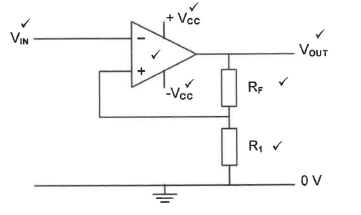 (7)
(7)
2.5.3
- Thermocouple
- Piezo-sensor
- Microphone (2)
2.5.4 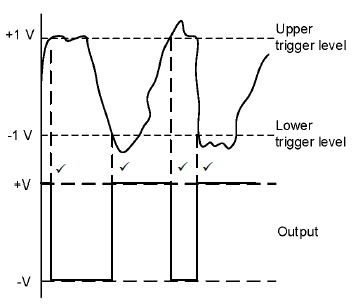 (4)
(4)
2.6
2.6.1 Inverting comparator (2)
2.6.2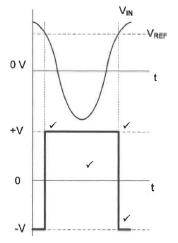 (4)
(4)
2.6.3 Change the connection of resistor R1 from the positive supply to the negative supply. (2)
2.7
2.7.1 The gain of the amplifier is determined by the ratio of the feed- back resistance to the input resistance of each branch. (3)
2.7.2 (3)
(3)
2.7.3 The amplifier is not saturated because the output voltage is less than the supply voltage. (2)
2.7.4
- VOUT = VIN ˣ Gain
Gain Av = VOUT
VIN
= VOUT
(V1 + V2 + V3)
= -6
(0,3 + 0,5 + 0,4)
= -5 (3)
2.7.5 If R2 is changed to 10 kΩ, the gain for V2 will increase causing the total output voltage to increase. (1)
[60]
QUESTION 3: SEMICONDUCTOR DEVICES
3.1
3.1.1 Pin 1 is to the left of the notch. OR The dot indicates pin 1. (1)
3.1.2
- It stabilises the amplifier.
- Distortion of the output signal is reduced.
- The bandwidth increases. (2)
3.2 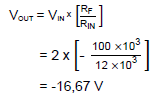 (3)
(3)
3.3 Dual Inline Package (1)
3.4
- Astable mode
- Bistable mode
- Monostable mode (3)
3.5
- Trigger pin 2 is an active low trigger.
- When the voltage goes higher than 10 V on the threshold pin 6, the output will reset to low. (2)
3.6 This pin sets the voltage at which the 555 will trigger. It is used to maintain the voltage across the timing capacitor which is discharged with the help of pin 7. (3)
3.7 A flip-flop is a memory cell, storing the information it last received until new information is received. (2)
3.8 Monolithic can be defined as a large circuit built on a single silicon chip. (2)
3.9 When an Op-Amp is connected to a circuit with no feedback connecting any of its output back to its inputs. (2)
3.10 +5 V/-5 V to +15 V/-15 V (2)
3.11
3.11.1 It senses the differential output from the first stage and amplifies this difference. (2)
3.11.2
- Very low output impedance
- A high current gain (2)
3.11.3 This stage has a single output terminal with its reference terminal taken as the 0V supply rail. The output voltage can swing both up to +Vcc rail and down to –Vcc rail. (3)
3.12
3.12.1 Non-inverting input (1)
3.12.2 Dual Inline Package (1)
3.13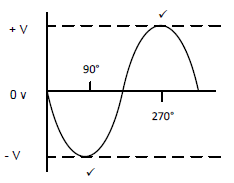 (2)
(2)
3.14
- In monostable condition, the 555 stays in one stable state.
- When an external trigger pulse is applied, the circuit will change its state to set.
- It will stay in this condition for a predetermined time, where after it will return to its stable state.
- The time constant T = 5RC determines how long it will be in the set state before returning to the original state. (4)
3.15
- Two comparators
- One S/R Flip-Flop (2)
[40]
QUESTION 4: DIGITAL AND SEQUENTIAL DEVICES
4.1
- A liquid crystal display (LCD) controls the passing of light by controlling the polarity of the polarity grids.
- By polarising two grids at 90°, the light is blocked in both the vertical and horizontal planes. (3)
4.2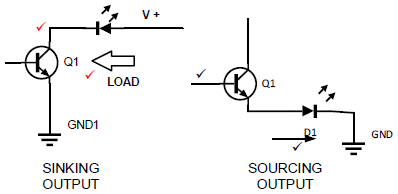 (4)
(4)
4.3
INPUTS | OUTPUTS | ||||||||||||
0 | 1 | 2 | 3 | 4 | 5 | 6 | 7 | 8 | 9 | A3 | A2 | A1 | A0 |
1 | 1 | 1 | 1 | 1 | 1 | 1 | 1 | 1 | 1 | 0 | 0 | 0 | 0 |
1 | 0 | 1 | 1 | 1 | 1 | 1 | 1 | 1 | 1 | 0 | 0 | 0 | 1 |
1 | 1 | 0 | 1 | 1 | 1 | 1 | 1 | 1 | 1 | 0 | 0 | 1 | 0 |
1 | 1 | 1 | 0 | 1 | 1 | 1 | 1 | 1 | 1 | 0 | 0 | 1 | 1 |
1 | 1 | 1 | 1 | 0 | 1 | 1 | 1 | 1 | 1 | 0 | 1 | 0 | 0 |
1 | 1 | 1 | 1 | 1 | 0 | 1 | 1 | 1 | 1 | 0 | 1 | 0 | 1 |
1 | 1 | 1 | 1 | 1 | 1 | 0 | 1 | 1 | 1 | 0 | 1 | 1 | 0 |
1 | 1 | 1 | 1 | 1 | 1 | 1 | 0 | 1 | 1 | 0 | 1 | 1 | 1 |
1 | 1 | 1 | 1 | 1 | 1 | 1 | 1 | 0 | 1 | 1 | 0 | 0 | 0 |
1 | 1 | 1 | 1 | 1 | 1 | 1 | 1 | 1 | 0 | 1 | 0 | 0 | 1 |
(10)
4.4
4.4.1 Clock (1)
4.4.2 The driver transistors are used to feed LED in the display separately to ensure all bars are illuminated to the same level. (3)
4.4.3
INPUTS | OUTPUTS | |||||||||
A | B | C | D | a | b | c | d | e | f | g |
0 | 1 | 0 | 1 | 1 | 1 | 1 | 0 | 0 | 1 | 1 |
(4)
4.5
4.5.1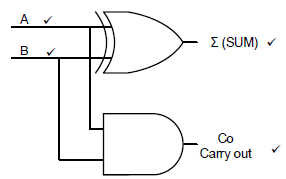 (4)
(4)
4.5.2
INPUTS | OUTPUTS | ||
A | B | Σ | CO |
0 | 0 | 0 | 0 |
0 | 1 | 1 | 0 |
1 | 0 | 1 | 0 |
1 | 1 | 0 | 1 |
(4)
4.6
4.6.1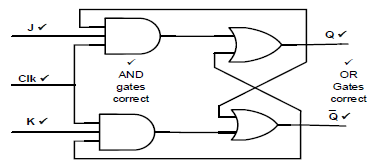
J-K Flip-Flop logic circuit (7)
4.7
- Asynchronous counter: Does not require an external clock pulse to operate.
- Synchronous counter: Requires an external clock pulse to operate. (2)
4.8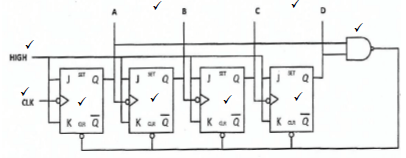 (9)
(9)
[55]
QUESTION 5: MICROCONTROLLERS
5.1
- Used in day to day devices
- Used in commercial devices
- Used in industrial control devices (2)
5.2 Production based on microcontrollers will be smaller, cheaper and more reliable. (2)
5.3
5.3.1 The current instruction register splits the instruction into two parts. One part is decoded by the control unit, ready for execution, the other part is the address of the data that needs to be used with that instruction. (2)
5.3.2 It detects an analogue signal and convert it into a digital signal. (2)
5.4
5.4.1 Registers are very fast working memory of a CPU. (2)
5.4.2 A register stores a single line of data instruction, a storage address or any other type of data. (2)
5.4.3
- Special purpose registers
- General purpose registers (2)
5.4.4 It stores a copy of the current instruction been executed. (2)
5.5 (6)
(6)
5.6
5.6.1 A set of rules and regulations (1)
5.6.2 The electrical or mechanical method of passing information between devices. (2)
5.7
- Installed during manufacture and cannot be erased or programmed.
- It contains the information that is permanently needed, holding the programmes, operating systems, and data required to boot up.
- ROM is non-volatile as the memory is not lost when the circuit is switched off.(3)
5.8
5.8.1
- Simplex
- Duplex
- Half duplex
- Full duplex (2)
5.8.2 Parallel communication is much faster. (1)
5.8.3
- Needs a clock pulse to both sender and receiver.
- Operates on a master/slave configuration, which means the sender has control over the operation and the receiver is the slave.(3)
[35]
TOTAL: 200